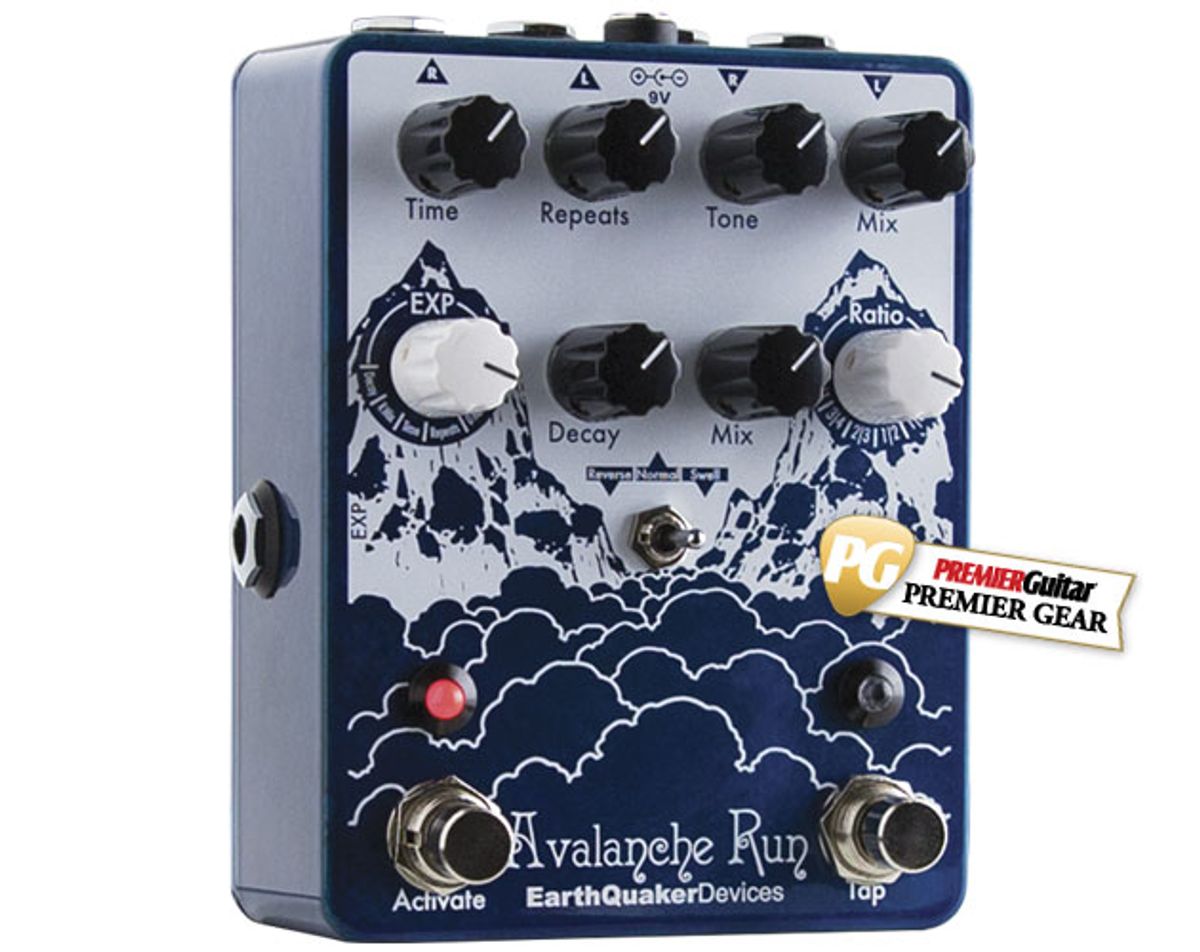
Digital expansiveness and inviting, expressive functions add up to a potent, outer-limits echo instrument.
As far as I know, EarthQuaker Devices’ new Avalanche Run is not designed to emulate a classic tape delay. But few digital delays deliver the tactile immediacy or time-warping potency of an Echoplex or Space Echo as satisfyingly as the Avalanche Run. It’s bubbling over with cool, digitally enabled features like reverse delay and reverbs long enough to bridge the space between planets. But with switchable expression-pedal functionality, wide control ranges, and a clever tap-tempo switch, it beckons you to dabble in echo manipulation of the most experimental sort.
Twister Central
The Avalanche Run’s top four knobs—time, repeats, tone, and mix—govern the delay circuit, while the lower two black knobs—decay and mix—are for reverb. The two white knobs are rotary switches: The left one assigns a parameter to the expression pedal (not included), and the right one selects delay subdivisions in quarter-note, dotted-eighth, quarter-note triplet, eighth-note, eighth-note triplet, and 16th-note patterns. But it’s the little toggle that’s the key to the Avalanche Run’s multiple personalities. It switches between an impressive reverse delay, standard digital delay, and a swell delay that functions like an auto-volume pedal. Avalanche Run can also operate in stereo.
Ratings
Pros:
Powerful, functional control set. Natural-sounding reverse mode. Well-integrated reverb sounds. Extra-long and extra-short delay times. Assignable expression pedal functionality.
Cons:
Side-mounted expression input.
Tones:
Ease of Use:
Build/Design:
Value:
Street:
$295
EarthQuaker Devices Avalanche Run
earthquakerdevices.com
Mountains of Sound
Fans of EarthQuaker’s elegantly utilitarian Dispatch Master will be at home with the Avalanche’s basic delay and reverb textures. Analog purists may argue that the delays are relatively sterile. But that didn’t detract one bit from my enjoyment of a Telecaster, a Bassman, and a little slapback and short-decay reverb. In fact, the almost-negligible coloring of the repeats and reverb allowed more room for the guitar and amp voices. When I did perceive a touch of digital sharpness in the repeats, I could easily add a touch of analog-style haze with the delay section’s tone control. It’s also worth noting that the delay and reverb blend very naturally. This cohesiveness and the basic clarity of repeats are significant factors when you stack echoes and sounds in the pedal’s more extreme settings.
Outer Limits
Avalanche Run gets pretty out-there before you even get to the reverse, swell, or expression-pedal functions. The rather insane delay range—up to two seconds—enables everything from artificial double-tracking micro delays to Echoplex-like sound-on-sound effects. The former sounds amazing for overdriven leads and heavy reverb settings. The latter is beautiful for languid, freestyle psychedelic picking. If you’re into the second alternative, I recommend getting an expression pedal. Depending on which parameter you choose to control, you can use the space in extra-long delays to dramatically alter reverb or delay mixes, or ride the repeats to create rhythmic waves of echo. Expression-pedal control of delay time can generate warped bird-call and hyperspeed-to-dead-stop Doppler effects that sonically approximate a projector running backwards and forwards at constantly variable and wildly different speeds. Another bonus: Holding the tap-tempo switch down generates self-oscillation, so if you can put two feet to work, the collage of textures you can fashion becomes downright demented. Any potential weirdness in standard delay mode multiplies tenfold in the very natural-sounding reverse mode. But it isn’t just about heavy-handed hallucination effects. Low decay and mix settings deliver more surreal versions of the motion you get from modulated echoes, animating simple arpeggios and spacious leads. Elsewhere, reverse mode excels at Kubrickian distortions of time and space. The shortest repeat times deliver metallic, ring-modulated tones that are extra trippy with heaps of reverb, while longer repeat, delay, and mix times—with aggressive reverb—are the stuff of ambient/shoegaze dreams.
The Verdict
The Avalanche Run can be a lot of things to a lot of people: space-ambience generator, tape-echo stand-in, and riff machine. It’s thoughtfully designed and deeply musical, and it reveals a seamlessness between functions and sounds that can make the most arcane features feel full of potential.


